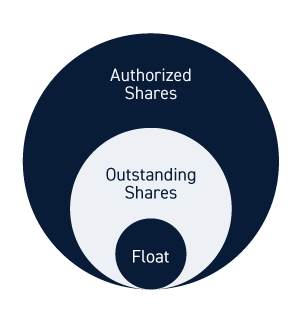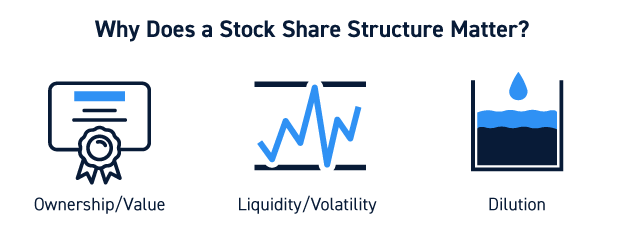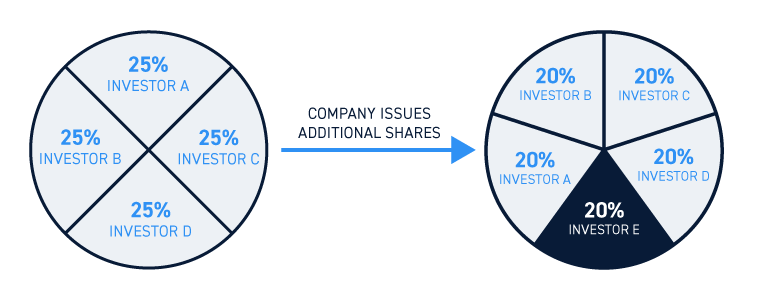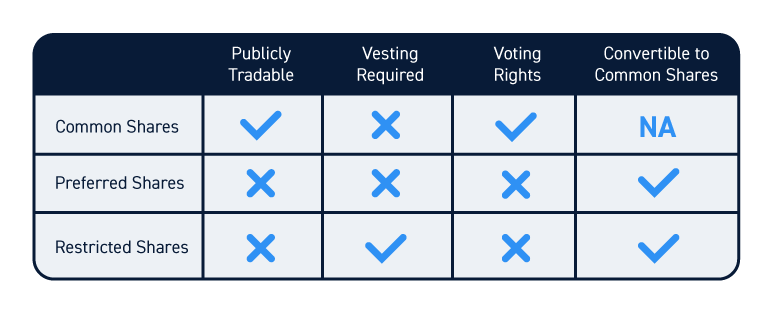Stock fundamentals often don’t play a big role in trading. But one set of fundamentals every trader should know about is share structure. A stock’s share structure impacts everything from how liquid a position will be to how likely it is that existing shares could be diluted.
In this guide, we’ll explain everything you need to know about stock share structure and how it can affect your trading.
What is a Stock?
To understand a stock’s share structure, we need to go back to the basics of how stocks work. A stock is essentially a piece of ownership in a company. The more shares you own, the more of the company you own.
What is a Stock’s Share Structure?
A stock’s share structure is a description of how a company’s shares are split up. That is, it reflects how many shares exist and how much ownership of a company each share represents.

At the end of the day, the ownership in a company represented by a single share matters more than the price of that share. Say, for example, two different stocks are each priced at $100. One may represent 0.0001% ownership of a company per share, while the other could represent 0.1% ownership per share. That’s a big difference, and share structure reflects that.
Why Does a Stock Share Structure Matter?
Share structure matters for a few reasons.

First, as we just explained, it reflects the ownership value of each share. When making big trades, it’s important to think about how much ownership you have in a company.
Second, stock share structure can impact how a stock trades. Stocks with more shares available tend to have more liquidity. Stocks with fewer shares have less liquidity, which could make them more volatile and difficult to trade.
Finally, share structure can impact the future value of a company. For example, say a company is able to issue new shares freely. A new issuance would dilute the value of existing shares, likely throwing a wrench into any ongoing trades you have.
Stock Structure: The Basics
Now that you know what a stock’s share structure is and why it matters, let’s dive into the details. We’ll start by explaining the different metrics used to describe a company’s share structure.

Authorized Shares
A company’s number of authorized shares is the total number of shares that can possibly be issued. This often isn’t the same as the number of shares on the market. Rather, it’s the total potential supply, if a company decided to issue all of the shares it legally could.
Outstanding Shares
The number of outstanding shares a company has is the number of shares that have already been issued. It includes shares held by company insiders and institutional investors, so the number of outstanding shares isn’t necessarily the number of shares available for trading.
If a company’s outstanding shares are much lower than the authorized shares, it’s possible that the company could issue new shares in the future.
Float
A company’s float is the number of shares that are available for trading. Unlike outstanding shares, float doesn’t include restricted stock held by company insiders.
Float is the most relevant aspect of share structure for traders. Low float can lead to low liquidity, which in turn makes it hard to get in and out of positions quickly. In addition, stocks with low float relative to outstanding shares may be highly affected by large insider trades.
Stock Structure: Types of Shares
In addition to issuing varying numbers of shares, companies can issue different types of shares.

Common Shares
Common shares are the type of share that most traders and investors are interested in. Typically, when trading a company’s stock, traders are buying and selling common shares. The vast majority of shares issued by most companies are common shares.
Common shareholders are last in line to receive a payout in the event that a company goes bankrupt. Common shares may confer a dividend, but this is at the discretion of a company’s board and a dividend is never guaranteed. Common shares also confer voting rights on shareholders.
Preferred Shares
Preferred shares are a type of share that typically confer a fixed dividend in perpetuity. They are more similar to bonds than common stock, although preferred shareholders fall behind bondholders in priority if a company goes into bankruptcy.
Preferred shares do not confer voting rights. However, preferred shares may be convertible to common shares or they may be repurchased by a company in the future at a premium to their original issuance price. These features often push up the price for preferred shares on the open market.
Restricted Shares
Restricted shares are shares awarded to company insiders and employees. They cannot be sold until they become vested, which may occur after a certain length of time or after specific corporate milestones are achieved. When restricted shares become vested, they can be sold and are considered as part of a company’s float.
Other Considerations
Types of Ownership
Another thing to consider when evaluating a company’s share structure is who owns outstanding or float shares. There are three categories of owners:
- Retail investors
- Institutional investors
- Company insiders
Shares held by institutional investors and company insiders are included in a company’s float (although this does not include restricted shares that have not vested). However, institutional investors and company insiders typically don’t buy and sell shares every day. For traders, this means that liquidity depends in large part on the number of shares held by retail investors.
In addition, when institutional investors and company insiders do buy and sell shares, it’s newsworthy. Company’s share prices often react to large volumes of institutional or insider buying and selling activity. This can significantly impact a company’s share structure and create opportunities for trading.
Company History
It’s also worth looking at how a company’s share structure has changed in the past. If a company has frequently diluted existing shares with additional offerings in the recent past, consider that a red flag.
At the same time, exploring the reasons behind past stock issuances can provide important insights. For example, if a company recently issued new stock as a way to get capital for expansion, that could provide fundamentals-based support for a momentum trade.
Conclusion
A stock’s share structure provides a window into who owns a company, how many shares are available for trading, and more. You can use this information to your advantage to spot trading opportunities and to avoid positions in companies that may have low liquidity or a history of share dilution.






